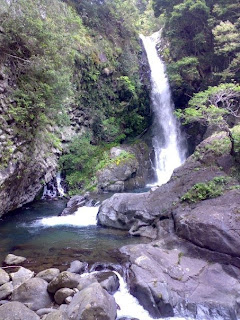Dopo 4 ore di treno ci rendiamo conto di quanto siano diverse le cose che a Tokyo: le strade sono strette e piene di tornanti, i trasporti non sono cosi ottimi e ci si deve affidare agli autobus solamente, la gente è più accomodante...
Shimoda è alla punta sud della penisola, baciata da estati lunghe e soleggiate, ricca di spiagge bianche e fini, con una storia non indifferente. E' a Shimoda, infatti, dove il commodoro americano Perry, dopo un bicentenario di isolamento totale per il Giappone, approdò con la sua ormai famosa Black Ship, segnando la riapertura del Sol levante all'occidente.
Un sito affascinante, vicino la spiaggia di Shirahama, è il tempio, con il suo torii in cima a un grosso scoglio, proprio a una estremità della spiaggia, che guarda verso l'oceano dall'alto della roccia.
Da Shimoda ci siamo poi spostati a vedere altre città della penisola, dovendo imparare anche che i biglietti dell'autobus si fanno non all'inizio, come a Tokyo, ma alla fine, prima di scendere, perchè il costo varia con la distanza.
Dogashima si trova sul fianco ovest di Izu, ed è caratterizzata da coste rocciose e lisce. Il mare e il vento hanno scolpito le isole lungo la costa disegnando linee orizzontali sinuose e particolari. Tutte le isolette sono bianche come la pomice e sono ricoperte da vegetazione. Peccato che la giornata era nuvolosa, anzi pioveva anche a un certo punto, e quindi la vista della baia non è stata un granchè.
Dogashima è anche famosa per le orchidee: esiste una sorta di museo-giardino, dove centinaia di varietà di orchidee sono esposte (e in vendita) al pubblico.
C'è anche una specia di parco divertimenti in stile amazzonia: un foresta con scimmie, ponti sospesi e liane...quello ce lo siamo risparmiati.
Al centro esatto di Izu c'è invece Kawazu, che è famosa per un gruppo di cascate naturali,dette Nanadaru (le sette cascate: Kama-daru, Ebi-daru, Hebi-daru, Shokei-daru, Kani-daru, Deai-daru, Oh-daru) sopra le quali i giapponesi ci hanno subito costruito una leggenda riguardante uno studente e una danzatrice e l'amore impossibile tra i due.
La bellezza del posto, le cascate, l'aria fresca, tutto ha contribuito a rendere la gita a Kawazu la tappa migliore della vacanza.
La punta estrema, invece, di Izu, è Irozaki. Questa parte di terra è caratterizzata da scogli vulcanici e alti precipizi, e mi ha ricordato il mare di Acicastello per la sua limpidezza e per il suo colore. Ma a parte il panorama che si vede dal promontorio non c'è altro a Irozaki. Solo natura selvaggia.
*****************
My first real trip in Japan after the arrival, during the lonegest national holiday of the year, known as Golden Week, brings me to Izu, peninslula south of Tokyo rich in vegetation, beaches, spas, mountains.
After a 4 hours train ride, we realize how different things are from Tokyo: roads are narrower and turning, transportation is not so optimal and one has to rely on buses only, people are more welcoming...
Shimoda is in the South of the peninsula, blessed with long and sunny summers, rich in fine white sand beaches, and with some important historical happenings. It is in Shimoda, in facts, where American Commodore Perry, after a two centuries of total isolation for Japan, arrived with his famous Black Ship, marking the opening of Rising Sun to the West.
A charming site is the temple right near Shirahama beach. It's got a torii on top of a big rock, at one end of the beach, that looks over the Ocean from up there.
From Shimoda we went to see other places, and meanwhile learnt that the bus tickets are to be paid not at the beginning, like in Tokyo, but at the end of the ride, because the cost increases with the distance.
Dogashima is on the West side of Izu, and it's made of smooth rocky coasts. The sea and the wind had carved the islets scattered in the bay, drawing peculiar horizontal stripes. All the islets are made of white rock and are covered with vegetation. Unfortunately the day was cludy, and it actually rained at one point, so the view of the bay wasn't that special.
Dogashima is also famous for orchids: there's a garden-museum where hundreds of different varieties are exposed (and sold) to the public. There's even a park, amazon forest-like, with monkeys, suspended bridges and so on....but we saved ourselves from going there.
In the right centre of Izu is Kawazu, which is famous for its waterfalls, called Nanadary (seven waterfalls:Kama-daru, Ebi-daru, Hebi-daru, Shokei-daru, Kani-daru, Deai-daru, Oh-daru) and on those the Japanese built a legend about a student and a dancer and the impossible love between the two.
The beauty of the place, the water, the fresh air, everything contributed to make the trip to Kawazu the best of the whole vacation.
The extreme tip, instead, is Irozaki. Here only cliffs and high volcanic rocks, and they reminded me of Acicastello and its sea, for the clearness and color of the waters. But, put aside the view one has from the top of the hills, there's nothing else in Irozaki. Just wild nature.






No comments:
Post a Comment